#Grindavik Town
Text

Local residents watch as lava-fueled smoke colors the night sky orange. This volcanic pyre has already cemented its reputation as one of the most consequential and scientifically beguiling Icelandic eruptions of the last few decades. Photograph By Kristen Elizabet Gunnarsdottir, AFP/Getty Images
Why Iceland's Latest Eruption May Be The Most Dangerous In Recent History
The December 18 explosion is the region’s fourth in three years—and has fired out 10 times more lava per second than any of the past three at their peaks. Here's what happens next.
— By Robin George Andrews | Published December 19, 2023
It was perhaps only a matter of time before Iceland’s Reykjanes Peninsula ran out of luck.
During the night of December 18, the peninsula exploded in a volcanic outburst—its fourth in under three years, and a decidedly dangerous entry in the Nation’s Volcanic Saga.
Just two hours after a swarm of earthquakes warned of the impending eruption, it was firing out 10 times more lava per second than any of the past three at their peaks, all while the fissure itself expanded to an astonishing 2.5 miles in length in a matter of minutes.
After nearly a millennium of dormancy, this southwesterly strip of land entered a new volcanic era in March 2021. The past three eruptions—in 2021, 2022, and earlier this summer—were nothing less than scientific and aesthetic spectacles. The last time there was a period of multiple eruptions on the peninsula was in the early 13th century. That it is undergoing another similar span of lava-oozing eruptions is one reason the world has been watching so closely.
But this fourth eruption has caught the attention of the international media for another three reasons: the ramp up to the main event was unusual compared to the last three; the location, combined with its vigorous opening salvo of molten rock, threatens to destroy a town; and its overall behavior created an uncomfortable amount of uncertainty as to what may happen next.

The evacuated Icelandic town of Grindavik is seen here as smoke billows and lava is thrown into the air from a fissure during a volcanic eruption on the Reykjanes Peninsula on December 19. The eruption began on Monday night following an earthquake swarm. Photograph By Viken Kantarci, AFP/Getty Images
“Just in context of the past three years on the Reykjanes Peninsula, it is pretty mind-blowing,” says Tom Winder, a volcano Seismologist at the University of Iceland.
As of the afternoon of December 19, just a third of the fissure remains volcanically active, and the eruption’s output has greatly diminished. Things could still change for the worse, but hopefully it continues to fizzle.
Regardless, this volcanic pyre has already cemented its reputation as one of the most consequential and scientifically beguiling Icelandic eruptions of the last few decades—which is why scientists from across the world are on the case gathering clues to its origins.
A Chaotic Prelude
Although most people understandably think of volcanic eruptions as coming from a volcano, all four of the most recent eruptions have actually been fissure-style: when lava forces its way out of Earth’s crust through a newly formed thin crevasse, often at location that cannot be identified prior to the paroxysm. Unpredictable fissure eruptions happen around the world, including on Hawai‘i, but they aren’t as well known.
But this latest eruption is especially notable because it did something the 2021, 2022, and mid-2023 events didn’t. Instead of materializing once again in a secluded spot near the volcanic mountain of Fagradalsfjall, it made its underground way to Svartsengi—home to a region-critical geothermal power plant, the tourism hotspot Blue Lagoon spa, and the 3,500 people living in the coastal town of Grindavík.
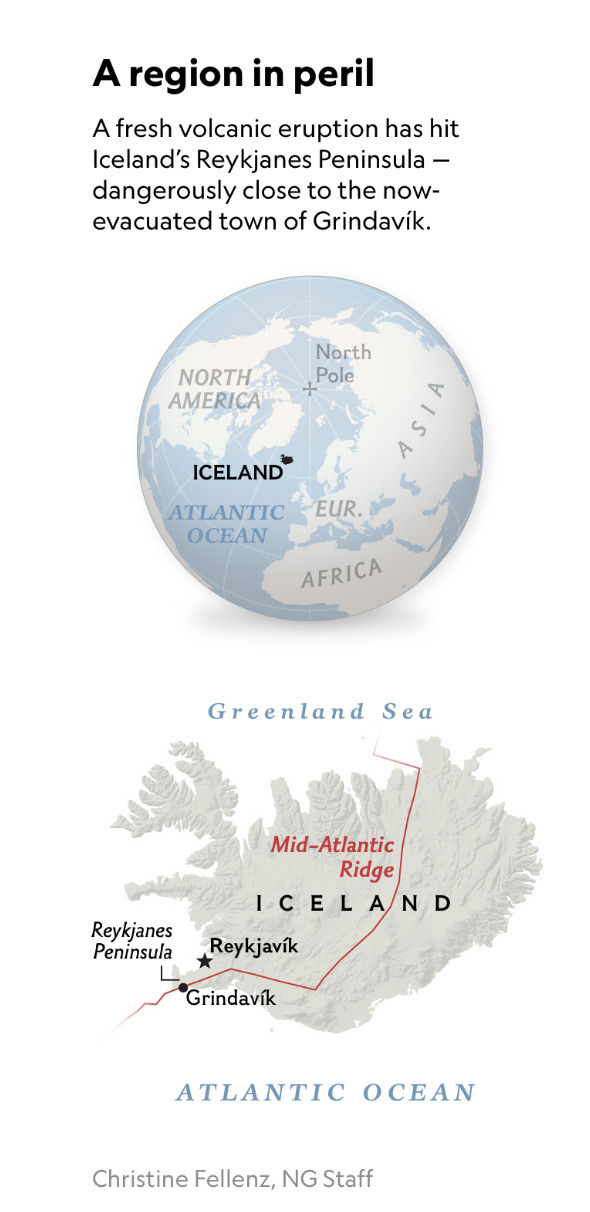
And it made quite an entrance: On November 10, the magma suddenly rose to within a few hundred feet of the surface, before pausing—all to the tune of a cacophony of rock-breaking quakes.
“This shift in the system reopening was honestly quite surprising. But it was the scale of the earthquake activity that took most people by surprise,” says Samuel Mitchell, a volcanologist at the University of Bristol. A pause between magma’s ascent and the onset of the eruption is not uncommon for fissure events, but this eruption’s prelude was especially intense and hasty.
By mid-November, it seemed very likely that an eruption along a 10-mile surface ‘corridor’ was going to happen in the coming days or weeks—a corridor that included Grindavík.

Iceland's Reykjanes Peninsula exploded in volcanic eruptions on December 18—creating an astonishing 2.5-mile-long fissure whose southern segment is seen here near the coastal town of Grindavik. Photograph By Marco Di Marco, AP Photo
Location, Location, Location
For the international eruption watchers, thoughts of another colossal, persistent, flight-grounding ash cloud—as was seen during Iceland’s 2010 Eyjafjallajökull eruption—attracted concern. Fortunately, as magma isn’t being directly injected into the underbelly of an ice sheet this time around, prolific ash-generating explosivity is extremely unlikely.
But its location did indicate that, unlike the past three events, this eruption could cause some serious damage
It was a good thing the molten rock’s prelude wasn’t subtle: It handily convinced authorities to swiftly evacuate Grindavík that same day in November, keeping residents far from any potential harm, while giving officials time to erect lava-deflecting walls around the power plant.
Still the eruption had an element of surprise: Lava began to spew just about two hours after an earthquake swarm just north of the town signaled the impending eruption—an astonishingly short interlude. That “underlines how close we were to an eruption soon after the initial evacuations last month, and the reason they were essential to ensure people's safety,” says Winder.
That the magma ultimately found a skylight near a series of ancient craters a couple of miles to the town’s northeast was briefly relieving. But the intensity of the eruption and the shocking growth of the fissure quickly made clear that the town to the south, and the power plant to the west, were in jeopardy.
For now, however, the grimmest of eventualities may have been avoided—all thanks to a mixture of luck and Icelandic proactivity.

Police have closed off the junction toward the town of Grindavík, which was evacuated in November as the threat of volcanic activity loomed. Experts say the hasty and intense eruption underlines how essential those evacuations were to ensure residents' safety. Photograph By Karim Iliya
The Fuzzy Future
That very little about the eruption is known with certainty also bolsters its intrigue.
Just a day into its paroxysm, the eruption noticeably calmed down, and it seemed possible that it would die out in a matter of days. Alternatively, experts say, this behavior might indicate that it will continue pumping out lava at that modest rate for months.
“If the magma stored at Svartsengi is still being renewed from depth, then the eruption could reach equilibrium at a lower intensity, and continue for quite some time,” says Winder. “It looks like there has been near-continuous magma supply there since late October, so it certainly seems realistic that it might continue for another two months into the future.”
That the region’s subsurface volcanic plumbing is a largely unresolved puzzle only exacerbates the uncertainty of this crisis. It simply isn’t clear why Svartsengi was the magma’s target this time round. Did it migrate from Fagradalsfjall, or did it come from another subsurface store? And why has the ground around Svartsengi inflated before without producing an eruption, whereas this time it succeeded?
In less than 24 hours after it began, researchers managed to sample some of the new eruption’s lava and compare it to the past three on the peninsula. And according to Ed Marshall, a geoscientist at the University of Iceland, they all have broadly similar chemistry. That implies there is some sort of magmatic connection between Svartsengi and Fagradalsfjall—but the nature of that connection is very fuzzy at present.
What volcanologists want to know, above all else, is what happened between the seismic dramatics of early November and this week’s eruption. Could they have been able to forecast exactly when and where the magma would find its way to the surface with the data they obtained in the weeks leading up to the outburst? “This is a great and intriguing question, which is at the core of what many people will be looking at in the coming months,” says Mike Burton, a volcanologist at the University of Manchester.
For now, all scientists can do is monitor the infernal proceedings—and hope that their observations will, eventually, reveal the secrets behind this novel show of volcanic force.

A volcanic fissure spews lava and smoke as it erupts near the town of Grindavík, Iceland, on January 14, 2024. The eruption is the latest in a series of outbursts that could continue in the region. Photograph By Snorri Thor, Nurphoto/Getty Images
#Iceland 🇮🇸#Reykjanes Peninsula#Most Dangerous Eruption 🌋#Grindavik Town#Tom Winder | Volcano Seismologist | University of Iceland 🇮🇸
1 note
·
View note
Text
OOoooooh shit its happening D:
I've been watching this for the past month... but hadn't heard much for the past few days so I was wondering if it would just stop without an eruption... but nope. Here it goes.
For those not in the know, the town of Grindavik was evacuated last month due to repeated earthquakes, and a Vulcanic fissure opening in the center of the town...
And now the Vulcano is erupting just north of town.
(and if you're in the doomy-mood... no this probably won't be the end of Iceland. They've had vulcanic eruptions in the past and are quite prepared...as prepared as you can be at least.)
#iceland#vulcano#grindavik#no need to ask if I am safe#I am about 1600 km away#I don't think the lava will flow across the ocean#Just freaking out because that's a lot of fire and its next to a town and aaaaa
4 notes
·
View notes
Text
🚨BREAKING: Iceland Volcano has just Erupted Near the town of Grindavík After Months of powerful Earthquake Swarms
Grindavík, Iceland 🇮🇸
After months of powerful earthquakes shaking the country's southwestern Reykjanes peninsula, a volcano has just started to erupt, unleashing large amounts of lava flows near the village of Grindavik. The village, housing around 4,000 people, has been evacuated. Officials are closely monitoring the Blue Lagoon, along with its geothermal plant near Grindavik, which serves as the primary provider of electricity and water to 30,000 residents.
#pay attention#educate yourselves#educate yourself#knowledge is power#reeducate yourself#reeducate yourselves#think about it#think for yourselves#think for yourself#do your homework#do some research#do your own research#ask yourself questions#question everything#nature#volcano#iceland
148 notes
·
View notes
Text

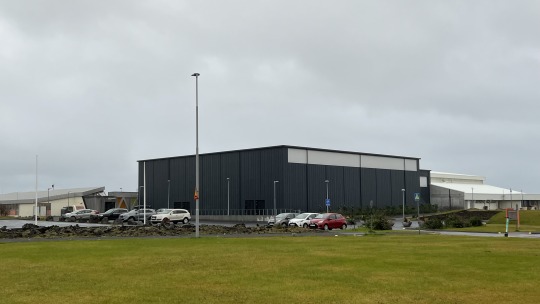
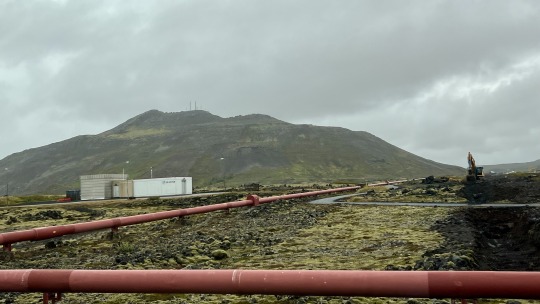
Grindavik, ísland, 2023.
The Sundhnúkagígar volcano which began erupting yesterday along a roughly 4 km fissure is spewing lava and gasses about 2 km from these scenes in the north end of the fishing town. These buildings, along with many others, are threatened. With a pre-emergency population of about 4,000, Grindavik has been evacuated since mid November. A nearby power plant complex, which provides geothermal heat and cheap electricity to about 10 percent of ísland's population, is also under threat.
14 notes
·
View notes
Photo



Icelandic volcano live: Lava reaches town of Grindavik - BBC News
13 notes
·
View notes
Text
Webcam captures the opening moment of the eruption of the Reykjanes volcano in Iceland
youtube
The long anticipated and feared eruption of the Reykjanes volcano finally occurred today, 12/18/2024, at 10:17 PM local time. Currently, lava is NOT advancing towards the town of Grindavik due to the ground in the area of the fissure being relatively flat, but it could be driven that way due to the sheer volume of magma being erupted. More will be known about the situation in the morning once the sun is up. The Svartsengi Power Plant and the Blue Lagoon are also currently safe. Construction of a berm/dike around them was completed last week with the exception of the road that goes to both. The road was ripped up to close the two holes in the dike barrier when the eruption began. The power plant is still operating as normal without issue and is being run remotely. The Blue Lagoon now notes on its website that it is temporarily closed due to the volcanic eruption.
13 notes
·
View notes
Text
President Gudni Th. Johannesson said in a televised address late Sunday that “a daunting period of upheaval has begun on the Reykjanes peninsula,” where a long-dormant volcanic system has awakened.
A volcano on the peninsula erupted for the second time in less than a month on Sunday morning. Authorities had ordered residents to leave the fishing town of Grindavik hours earlier as a swarm of small earthquakes indicated an imminent eruption.
Geophysicist Magnus Tumi Gudmundsson said Monday morning that the eruption had “decreased considerably” overnight, but that it was impossible to say when it would end.
Grindavik, a town of 3,800 people about 50 kilometers (30 miles) southwest of the capital, Reykjavik, was previously evacuated in November when the Svartsengi volcanic system awakened after almost 800 years.
The volcano eventually erupted on Dec. 18, sending lava flowing away from Grindavik. Residents were allowed to return to their homes on Dec. 22.
Since then, emergency workers have been building defensive walls that have stopped much of the lava flow from the new eruption short of the town.
No one has been killed in the eruptions, but a workman is missing after reportedly falling into a crack opened by the volcano.
“We don’t yet know how this eruption will unfold, but we must still take those actions that are within our power,” the president said.
“We continue to hope for as good an outcome as possible, in the face of these tremendous forces of nature,” he added. "We will carry on with our responsibilities and we will continue to stand together.”
Iceland, which sits above a volcanic hot spot in the North Atlantic, averages one eruption every four to five years. The most disruptive in recent times was the 2010 eruption of the Eyjafjallajokull volcano, which spewed clouds of ash into the atmosphere and disrupted trans-Atlantic air travel for months.
The latest eruption isn’t expected to release large amounts of ash into the air. Operations at Keflavík Airport are continuing as normal, said Gudjon Helgason, spokesman for airport operator Isavia.
7 notes
·
View notes
Text
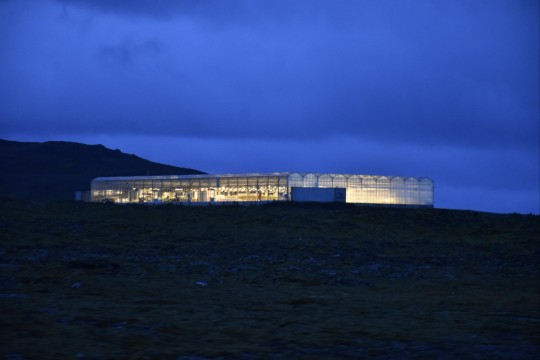
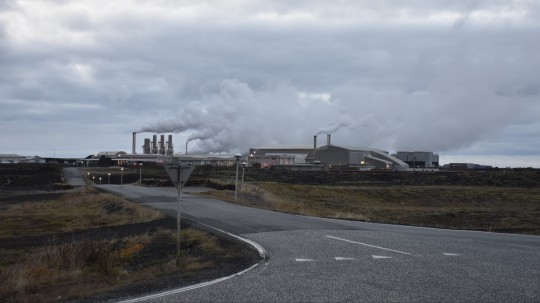
Speaking of the eruption I actually drove through Grindavik last month, I remember thinking it was such an odd suburban town in a lava field. Sad to hear about the magma chamber forming and people loosing their homes.
Above is the nearby Bioeffect greenhouse and the svartsengi geothermal plant (where the water for the blue lagoon comes from)
#one of these was taken by a classmate and one is mine#unsure which because sometimes i accidentally apply a high kelvin by mistake#haven't brought this up because my mind has been stuck on another area of the world tbh
7 notes
·
View notes
Text
ICELAND magma intrusion Saturday Nov 11
youtube
FWIW I have found geologist Shawn Willsey's English-language videos to be clear, comprehensible, and non-hype covering the situation at the fishing town of Grindavik for people outside Iceland (I expect Icelanders have more current information locally)
12 notes
·
View notes
Text
Ngl, my heart sank when I read this
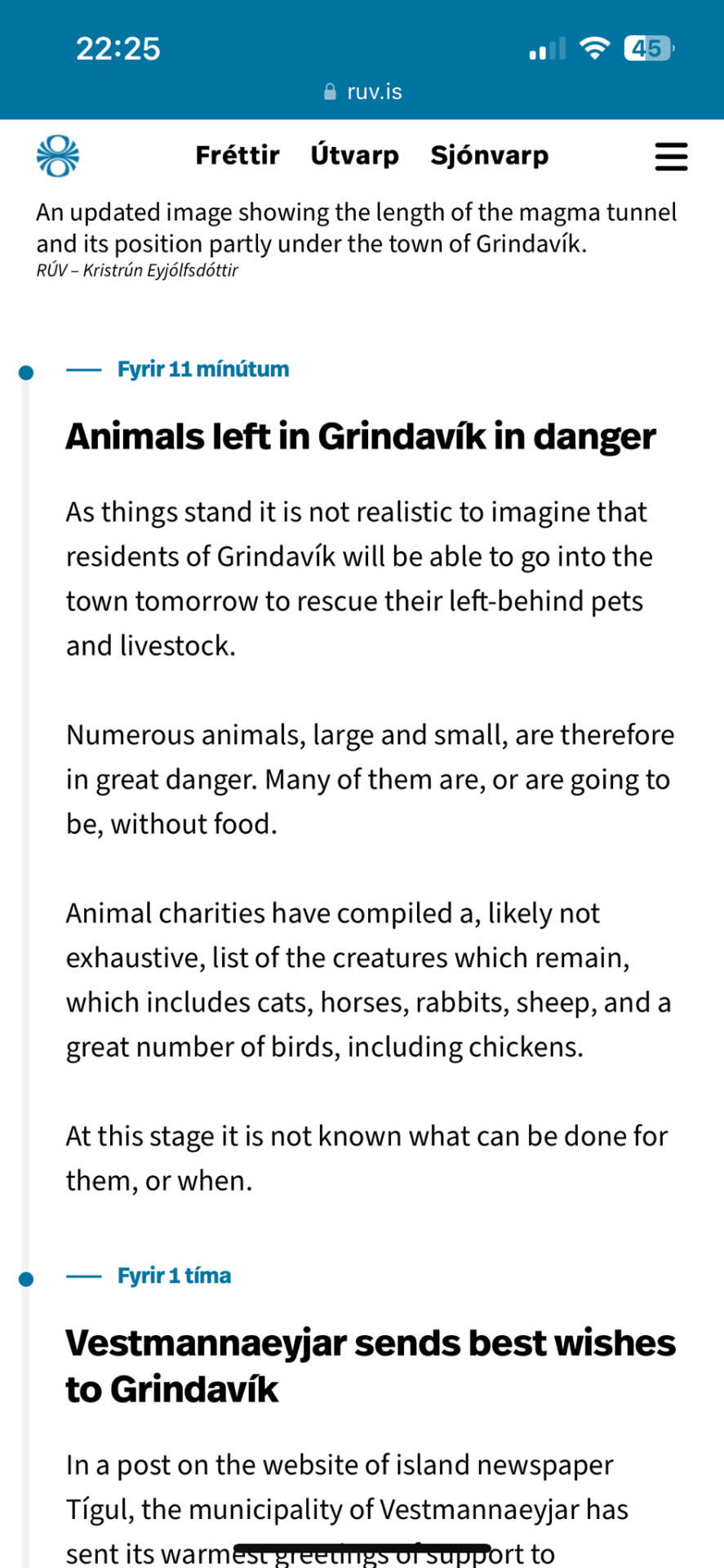
It’s the very realistic part of an imminent eruption and the fast evacuation of Grindavik, but it’s incredibly grim.
Update: my mum read in an Icelandic paper (she doesn’t remember which) that people have been moving horses away from dangerous areas.
(Earthquakes under and near the town of Grindavík gave serious concern for another lava eruption in the south of Iceland. As it currently stands the lava is 800m beneath the surface. The people of Grindavík were evacuated last night.)
Source: https://www.ruv.is/english/2023-11-10-magma-tunnel-under-grindavik-eruption-likely-live-396249
8 notes
·
View notes
Text

The image is from here: https://www.visir.is/g/20232488349d/vaktin-thaer-bjargir-verda-tha-til-stadar-
This is what is going on in Iceland right now. (In a small town called Grindavik.)
4 notes
·
View notes
Video
youtube
Incredible Footage of the Volcanic Eruption in Iceland
On December 18, a volcano surfaced on Iceland's Reykjanes peninsula, near Grindavik and the Blue Lagoon. This event marked the awakening of volcanoes in the region after an eight-century dormancy.
The emergence was triggered by the movement of the Eurasian and North American tectonic plates pulling apart.
Preceding the eruption, the area had been experiencing earthquakes for two months. Due to concerns that the volcano might surface under Grindavik, a town with nearly four thousand residents, evacuation measures were implemented on November 10.
4 notes
·
View notes
Text
youtube
A volcano has erupted in south-western Iceland, spurting lava fountains more than 100 metres into the air. It began on Monday not far from the town of Grindavik in the most populous region – where evacuations have taken place. Authorities had been expecting the eruption but have been left surprised by its size and intensity. For more on this, we talk to Bjarni Yónsson. He is a news reporter for the Icelandic National Broadcasting Service RUV and joins us now from the capital Reykjavik.
6 notes
·
View notes
Text


Fresh Flows Across Iceland
"Lava poured from a volcanic fissure near the town of Grindavík, Iceland, in spring 2024. The eruption, which began on March 16 and remained active over two weeks later, was the largest in a string of four volcanic events on the Reykjanes peninsula starting in December 2023.
The OLI (Operational Land Imager) on Landsat 8 captured this image of the ongoing eruption on March 30, 2024. The natural color scene is overlaid with an infrared signal to help distinguish the lava’s heat signature. The active part of the fissure and the origin of a volcanic plume are apparent. While the eruption was still active at this time, additional satellite and ground observations indicated it was likely waning.
The eruption began at 8:23 p.m. local time on March 16, the Icelandic Met Office (IMO) reported. A fissure nearly 3 kilometers (2 miles) long quickly opened in a similar location to the February 2024 eruption. Hundreds of people at the Blue Lagoon, as well as a small number in Grindavík, were evacuated within about 30 minutes of the eruption starting.
In the days that followed, lava flowed toward infrastructure such as water pipes and roads, the town of Grindavík, and the ocean. Human-constructed barriers of earth and rock diverted lava away from town, although a flow extended across one road. Officials were initially concerned that lava would reach the coast and cool rapidly upon contacting water. This could have posed additional hazards such as the production of hydrogen chloride gas, but the flow stopped short.
This Landsat image comparison shows the recent changes on the Reykjanes peninsula. In September 2023 (left), the area was quiet volcanically. By February 10, 2024 (center), three separate fissure eruptions had occurred. The footprint of new basaltic rock grew in March 2024 (right) as new lava spanned nearly 6 square kilometers (2.3 square miles), according to the IMO.
Like the eruptions that preceded it, the spring 2024 event was effusive, not explosive. Effusive eruptions tend to emit minimal ash, and their plumes typically contain water vapor, sulfur dioxide, carbon dioxide, and small amounts of other volcanic gases.
This eruption did not disrupt air travel, but sulfur dioxide (SO2) emissions were hazardous locally at times. Workers evacuated the power plant north of Grindavík on March 18 due to gas pollution, the Icelandic National Broadcasting Service reported. The SO2 emissions from this eruption were forecast to drift across the United Kingdom and northern Europe, according to models based on satellite observations, but at an altitude too high to affect surface air quality.
Unlike the other recent eruptions in this region, the springtime event stretched out over weeks rather than a couple of days. The reason for the relatively prolonged eruption may be that magma now has an easier path to the surface, experts suggested in news reports. Others think that magma is no longer accumulating in the shallow magma chamber beneath the area and that this eruption could be the last in the longer cycle.
NASA Earth Observatory images by Lauren Dauphin, using Landsat data from the U.S. Geological Survey. Story by Lindsey Doermann."
And to think we were there in September about the time the first photo was made! The main road connecting Grindavik to the remainder of Iceland has been cut in two places. According to their website, the popular tourist attraction Blue Lagoon is closed due to "unfavourable air quality" but is scheduled to reopen tomorrow 11 April.
Wish I could hop on a plane to see this in person, but other obligations preclude such a trip anytime soon.
6 notes
·
View notes
Link
Fears for the future of an Icelandic fishing town are mounting as a nearby volcano threatens to erupt at any moment - with a nine-mile fissure splitting the town in half and authorities saying that increased sulphur dioxide levels have been detected.
Aerial footage shows apocalyptic scenes in the small town of Grindavik, with huge cracks appearing in roads and under buildings which were completely deserted when all 4,000 residents were told to evacuate.
Residents who were allowed to return to their homes with emergency services to collect essentials were ordered to evacuate this afternoon after the Icelandic Met Office said their meters had detected increased levels of SO2.
Sulphur dioxide is a toxic gas released by magma as it rises to the surface, and high exposure is deadly to humans. If detected at a non-erupting volcano, it could be a sign that it will erupt soon.
6 notes
·
View notes